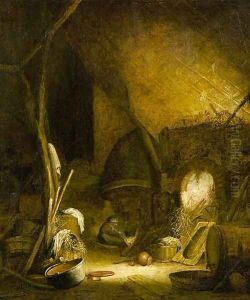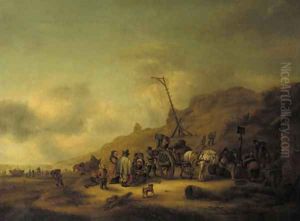Isaac Jansz. Van Ostade Paintings
Isaac Jansz. van Ostade was a Dutch painter and a prominent figure in the Golden Age of Dutch painting. Born in Haarlem in 1621, he was part of a family of artists, with his brother Adriaen van Ostade also being a well-known painter. Isaac's work primarily focused on the daily life of the Dutch peasantry, featuring lively tavern scenes, winter landscapes, and genre paintings that vividly depicted the customs and activities of the time.
Isaac was initially taught by his brother Adriaen, which had a noticeable influence on the early part of his career. His initial works were closely aligned with Adriaen’s style, focusing on the interior scenes of peasant life with a keen eye for detail and a warm, earthy palette. However, as Isaac developed his unique artistic voice, his work began to diverge, showing a preference for outdoor scenes and a brighter, more varied color palette.
Despite his relatively short life, van Ostade was prolific and his work was highly sought after, both in his own time and today. His ability to capture the nuances of light and atmosphere in his outdoor scenes was particularly admired, and he is credited with contributing significantly to the development of landscape and genre painting in the Dutch Golden Age. Tragically, Isaac's career was cut short when he died in Haarlem in 1649 at the young age of 28.
Throughout his career, Isaac Jansz. van Ostade was known for his innovative approach to painting, which included experimenting with perspective and the use of light to enhance the narrative quality of his scenes. His paintings are celebrated for their vivacity and the sense of joy they often depict, providing a window into the world of 17th-century Holland. Today, his works are held in high esteem and can be found in major museums around the world, where they continue to be studied and admired for their contribution to the Dutch Golden Age of painting.

